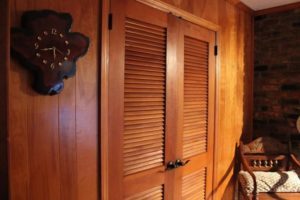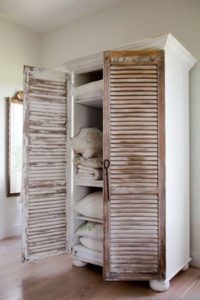Recently, built-in sliding door wardrobes are in great demand. But, you can think about furniture with swing doors. This is no less aesthetically pleasing and, most importantly, you can make such a cabinet yourself.
Preparation of materials and tools for creating a cabinet with louvred doors
The content of the article
- Preparation of materials and tools for creating a cabinet with louvred doors
- Assembly of a built-in cabinet with louvred doors
- Expert Advice
 First you need to measure a niche. For example, take the size: niche width - 120 cm, height: 240 cm.
First you need to measure a niche. For example, take the size: niche width - 120 cm, height: 240 cm.
REFERENCE: A very important parameter is the depth of the wall. If you are planning to organize a closet with a classic barbell (when things hang perpendicular to the door), you need to remember: the depth should not be less than 50 cm (standard size of the shoulders).
Let's say that we have a depth of only 50 cm. It should be noted that the facade itself will take 5 centimeters, therefore, we will not be able to use the standard rod option. But, on sale there is a euro-hanger - it is located sideways, and things are placed face to the doors.
Let's divide our furniture into two parts: on the right we will arrange a hanger, on the left - shelves.
How to make a built-in wardrobe with tambour doors do it yourself? So, we need:
- Standard louvered door facades (60 by 60 cm), we need to purchase 8 of them. The product can be painted in the required color.
- We need material for the partition and shelves - we will take the standard chipboard, which we sellers can cut and strip into the warehouse of materials. We need a part - 240 by 45 cm and 8 shelves - 60 by 45 cm.
IMPORTANT: the indicators are given taking into account the fact that the parts will be attached directly to the wall, if you need to use side walls, then consider the width of the laminate sheet (standard - 16 mm)!
It is necessary to take care of the details on which the doors will be installed. Details can be made visible or not, it all depends on the selected hinges. In our example, we will use regular loops. Therefore, the supplier must be asked to process two segments: height 240 cm, width 10 cm. Chipboard and the edge must be selected by color.
Also required:
- Self-tapping screws and special invisible fasteners (eccentrics) that will hold the partition and shelves.
- Screwdriver.
- PVC strips - for fastening door parts to each other.
- Barbell.
Assembly of a built-in cabinet with louvred doors
 So, we come to the most important part of the work - assembling the cabinet from the blinds with our own hands, the photo of which is above. First we install a partition. Before installing it, it is necessary to make holes in the laminate for screws (this can be done with a drill).
So, we come to the most important part of the work - assembling the cabinet from the blinds with our own hands, the photo of which is above. First we install a partition. Before installing it, it is necessary to make holes in the laminate for screws (this can be done with a drill).
It is necessary to measure exactly 60 centimeters from the left wall and begin to fasten the partition. Installation holes must be made in the wall, floor and ceiling.
Then, we proceed to the installation of shelves. We follow the same pattern as with the partition. Shelves will be 7 pieces, they must be evenly distributed.
We fix the remaining shelf in the right half of the installation. We will mount a hanger on it. Usually, the bar is placed according to the height of the owners, so that it would be more convenient to place clothes.
Let's set the part at a level of 180 cm from the floor (for people of average height). First we fasten the shelf, then to it, we install a hanger with screws.
It's time for strips of chipboard. We mount them perpendicular to the facade with self-tapping screws. Next, measure the distance between the loops.
Now we’ll make the doors: fasten the parts together on eccentrics and close the edges with tape - a corner of PVC. The final touch - hang the hinges and connect the doors to the sidewalls. Put the pens.
Expert Advice

- Professional manufacturers advise: before starting work, design a future product. This will allow you not to make a mistake with the sizes. Every little thing needs to be considered. For example, the width of the material.
- For the internal filling of the cabinet, you can pick up special baskets for things, put modern boxes, install nets and organizers for things.
- The choice of material: chipboard - a standard furniture option economy class, requires closing edges, does not allow moisture. MDF - is made of tightly pressed chips, covered with a PVC film, which protects the part from liquids, can be milled and does not require an edge. Plastic (PVC) is the most moisture resistant option, it is easy to be cut and processed at home. Any of the materials is suitable for filling the installation.


